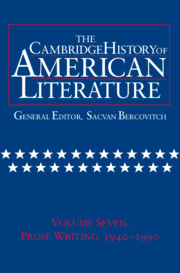Book contents
- Frontmatter
- Introduction
- The Drama, 1940—1990
- 1 Introduction
- 2 Tennessee Williams
- 3 Arthur Miller
- 4 Edward Albee
- 5 Sam Shepard
- 6 David Mamet
- 7 Changing America: A Changing Drama?
- Fiction and Society, 1940–1970
- After the Southern Renascence
- Postmodern Fictions, 1960–1990
- Emergent Literatures
- Appendix: Biographies
- Chronology, 1940–1990
- Bibliography
- Index
5 - Sam Shepard
from The Drama, 1940—1990
Published online by Cambridge University Press: 28 March 2008
- Frontmatter
- Introduction
- The Drama, 1940—1990
- 1 Introduction
- 2 Tennessee Williams
- 3 Arthur Miller
- 4 Edward Albee
- 5 Sam Shepard
- 6 David Mamet
- 7 Changing America: A Changing Drama?
- Fiction and Society, 1940–1970
- After the Southern Renascence
- Postmodern Fictions, 1960–1990
- Emergent Literatures
- Appendix: Biographies
- Chronology, 1940–1990
- Bibliography
- Index
Summary
Edward Albee had his roots in Off-Broadway. With Who’s Afraid of Virginia Woolf?, he moved to Broadway. Despite the deserved success of that play, it was not where he belonged. It is arguable that his work would have found a more receptive audience elsewhere. Certainly, an increasing number of writers turned not to the large-scale and increasingly expensive midtown theaters but to the Off-Broadway and Off-Off Broadway venues that sprang up, from the early 1960s onward. In a decade that privileged youth, that increasingly saw a challenge to conventional social structures, that witnessed social fragmentation along lines of race and gender, and that was defined by political and aesthetic revolt, the theater, as image and fact, seemed the natural focus of change. It was to be a theater that challenged the distinction between performer and audience, that stepped outside Cartesian logic and tapped into the unconscious as it rediscovered the expressive power of the body. Groups such as the Living Theatre, under the direction of Judith Malina and Julian Beck, and the Open Theatre, whose director was Joseph Chaikin, set themselves to explore the potential of the theater by deconstructing it into its component elements — movement, sound, the dialectics of performance. Their emphasis was on the actor. They were interested in liberating the voice, stressing physicality, generating powerful images, improvising, transgressing the supposed limits of theatrical expression. The audience they addressed was not one that attended Broadway plays.
- Type
- Chapter
- Information
- The Cambridge History of American Literature , pp. 52 - 64Publisher: Cambridge University PressPrint publication year: 1999

